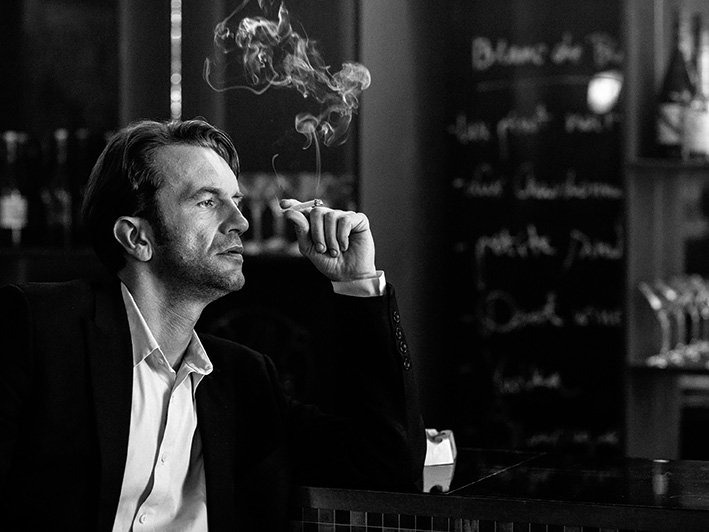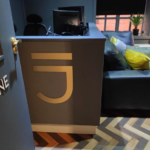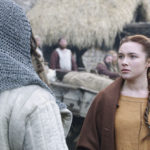
Dark Love
Posted on Jan 2, 2019 by Julian Mitchell

Cold War is the most colourful black & white film you’ll ever see and it could win the Academy Award for Best Foreign Language Film next year
words Madelyn Most / pictures Curzon & Lukasz Zal PSC
Director Pawel Pawlikowski and Lukasz Zal PSC collaborated on Cold War, which won Best Director in the Official Competition for the 2018 Cannes Film Festival. Their previous collaboration, 2013’s Ida, won 69 awards, including the Academy Award for Best Foreign Film and the BAFTA Award for Best Film Not in the English Language.
Pawel Pawlikowski says he always had the idea of making a film about a love story that was loosely based on his parent’s lives and many others who fled Poland for the West. After the success of Ida, he found an opportunity to realise this dream.
Ida was remarkable for its stark black & white imagery, but music is also an important element in Pawlikowski’s films. “I like music in films, rather than film music. When I write the script, the music is another layer that helps imagine the world, the period and the scene you are creating but I don’t intellectualise it,” he explains. “In Cold War, I needed something to bring the characters together and came across the wonderful Mazowsze folk ensemble that opened up a beautiful range of possibilities. This was a third element to explain the history during the Stalinist era and how music was used by the state. I would never start with politics, if there are political resonances today, it was not my intention.
 Cinematography Lukasz Zal.
Cinematography Lukasz Zal.
“I identified three songs performed by folk musicians for the soundtrack that had the potential of becoming jazz songs and these three became characters in the film,” he adds.
“Later, we are in Paris in the 1950s with jazz music and salons, and all those pretentious, over- educated people so full of themselves – it’s the complete opposite of Poland. There are other bits of music that helped out at certain points in the story to give it some energy. For instance, when Wiktor (played by Tomasz Kot) and Zula (played by Joanna Kulig) are lethargically sitting in a bar and Rock Around the Clock starts playing, Zula gets up to dance. It was a good moment to wake-up the audience”.
Commercial Risk
“This is an 84-minute film, covering a time period that spans 15 years and four countries,” says producer, Tanya Seghatchian. “With an unusual screen ratio – we had 57 shooting days. Making a black & white film is challenging – you lose half your audience, so it does limit the commercialviability of the film. But, we had Pawel and when you have Pawel Pawlikowski, you have an artist with integrity who is going to be his own worst enemy. If it meets with his high standards, it should meet with ours.”
 Actress Joanna Kulig who plays Zula and Tomasz Kot who plays Wiktor.
Actress Joanna Kulig who plays Zula and Tomasz Kot who plays Wiktor.
Producer, Ewa Puszczyńska, interjects: “The way Pawel works is scary for producers. It is not comfortable, good or friendly. It might turn your hair grey or give you an ulcer or a heart attack, but this is the way he makes his film… you just go with him. You understand his process and you follow.”
Some may be perplexed to read the end credits that list 14 producers, 10 production companies, six funding agencies and 15 distributors. “We had television financiers who back Pawel and public funders from previous films and now French collaborators. This kind of international co-production is indeed complicated, with various funding bodies in each of the three main participant countries and each one has different rules and terms of agreement,” says Tanya Seghatchian.
“But,” adds Ewa Puszczyńska, “all the legal contracts were done under British law. The contracts had 120 pages; others 89 pages. We make films in a different way in Poland, the budgets are not so heavily leaden with costly legal issues. That was one of the hardest parts of this production and it was a huge learning curve for me. You have to be prepared for that and now I am.”

Leading actor Joanna Kulig who plays Zula says: “Some small part of Ida was in Zula for me. I used my own voice singing and I trained for one year to learn how to dance. I had problems with my coordination, but I really worked hard. I was so happy, but surprised, to get compliments on my dancing from a professional ballerina. The most important thing for me was to be very free and open, and to do things naturally. Pawel does many takes – sometimes 16, 18 even, and the actors have to be very free. Now I understand why it was important – they look for the exact frame, for the right light. But we had a lot of time to get things just the way Pawel wanted. The script and the scenes were changing all the time, but we have a such an open relationship, that if we suggest something, and it works, we use it, if it was not good, OK, move on.”
Lukasz Zal
The titles on Cold War credit Pawel Pawlikowski with director, writer, screenplay and ‘Images’, while Lukasz Zal is listed as cinematographer. Zal was originally the camera operator on Ida in 2013 with cinematographer Ryszard Lenczewski, but when he fell ill in the first week of shooting, Lukasz was moved into the role of director of photography. “Even though I was 32, I looked young and Pawel kept calling me ‘the student’,” laughs Zal.
Lukasz Zal grew up in a small town in Northern Poland called Koszalin where there was only one cinema. He also had to wear glasses at a young age so his parents did not allow him to watch television as they feared his eyesight would get further damaged. Because of this, Lukasz’s interest in cinematography really began with his father’s love of photography.
 Lukasz Zal preparing for a shot with director Pawel Pawlikowski.
Lukasz Zal preparing for a shot with director Pawel Pawlikowski.
“My father constantly took photos of weddings, funerals and of our family with a Russian Zenit camera and a 6×6 START camera, the Polish version of a Hasselblad. I took photos with him and began to develop them in the darkroom at school,” says Zal. “When I was 15, they offered a film workshop and that is when I fell in love with motion pictures. My school and our city library had a media library where there were shelves full of VHS tape cassettes. They were labelled by categories (for example Director, Oscar-Winning, European Film, Russian Film, etc). I remember my parents asleep upstairs, while I stayed downstairs watching films all night long. I watched films from different European countries, including Poland by artists such as Bergman and Herzog. I did not know a lot about ‘American Cinema’ as there was no Internet then, so what I knew was from people talking about it. I knew about Spiderman, but I had not seen it.
“I didn’t treat film like entertainment, I was looking for films that touched my emotions. I did love stills photography, but I felt that film had a much stronger emotional impact. At that time, I was searching for a way to express myself. I tried different activities, such as acting in the theatre and working as a journalist, but I discovered that they were not for me. I finally found the medium where I could express myself and that was with film.”
 Director Pawel Pawlikowski and cinematographer Lukasz Zal check the monitor.
Director Pawel Pawlikowski and cinematographer Lukasz Zal check the monitor.
References
“On Cold War, we prepped from June 2016 to January 2017. We found references in many different places,” explains Zal. “We looked at a lot of still photography by artists, such as Ralph Gibson and Helmut Newton. We also watched films by Godard and Tarkovsky, and reviewed film archives of Paris and jazz photography from the 1960s and 1970s. We listened to musicians, such as Thelonious Monk and Miles Davis, and spent a long time watching the Mazowsze folk group. We then began to film their concerts and, later, the rehearsals with Joanna/Zula, looking for formal solutions.

“We created storyboards using photos and then began to catalogue the stills by the different locations for each scene. These storyboards started to represent what we wanted to capture in the frames when we finally went to shoot it. I kept a notebook and wrote in it every day – do this, Do NOT do that, but my last note was to ‘BE ready for the unexpected. Be open, BE FLEXIBLE, for anything unusual can happen’.”
Zal adds: “It was such a collaborative effort and everybody on set worked together to offer ideas and input. I cannot emphasise enough how the work of the amazing duoof production designers, Katarzyna Sobanska and Marcel Slawinski, made my lightinglook so interesting. The art directors and the set decorators were incredible. What a wonderful experience this was for us all. Judyta Pieprzyk and Anna Wołoszczuk, the set designers, did outstanding work and we all shared and enhanced each other’s ideas.”
Aesthetic
The production set out to make the look of Cold War different to Ida. “Pawel wasn’t able to shoot consecutively, so he shot the movie in pieces. When we would take a break from filming, Pawel would go into the cutting room to assemble it,” explains Zal. “He treats the script like a piece of paper, like a story he is carrying inside of him. In the cutting room, he is looking at what works and what doesn’t and then changes it as the film develops. Cold War starts off like a documentary, then phases into a more stylised narrative film and, in the end, becomes something magical and spiritual.
“Early on, we chose the 4:3 aspect ratio, 1X 1.37. At the beginning of the film in Poland, the frame is fairly static and we use wide shots and fixed prime lenses. When we meet Zula, we introduce movement, energy, singing and dancing, which motivates the camera to follow her. We get closer to our two protagonists and focus on their relationship. Using different lenses, they become distanced or separated from the background, which is now blurry or soft focus because of the shallow depth-of-field. It was funny; the producers complained that it ‘cost so much to film in Paris and we don’t see anything!’

“We wanted to keep the look for this film as simple as possible. The camera is used as a function and it moves when it needs to move and we felt the light design should come from the actual location.
“For instance, when we were in Poland during the winter, it had a bleached, grey look and when we were in Paris in the summer, we used the sun as we wanted a high contrast look. We were increasing the contrast and introducing grain into the image. We went to Paris with the gaffer and the production designers, and made detailed sketches of which street lamps we’d use and which ones we would not by turning them off.
“I’ve always used a lot of backlight, side light, rim light, but this is the first film in my career where I am using a beauty light, like Helmut Newton, where you put a front light directly on the actor close to camera. We were lighting the scene with one source. Most days, I watched rushes alone while Pawel was sending me his newest version of the cut and inviting me into the editing room.”
Film or digital?
Knowing it would be too expensive and impractical to shoot on film, Zal did camera tests with two cameras side by side: a 35mm film camera, and an Alexa with the same lenses. “We developed the 35mm negative and Michal Herman, the colourist, created two LUTS, one for day and one for night. We found the look we wanted on the 35mm print and discovered exactly how to get that same look on a digital camera.
“We did the camera tests on a set using the actors in their costumes and make up, using different types of lighting. This is where we learned that on the costumes we saw different shades of grey and different shades of black that almost blended, so we knew we needed to select costumes with bright yellows, dark greens and strong hues of purple, because those colours registered better. We were constantly looking for a contrast in production design, costume and lighting.
The colourist, Herman, says: “Grading the movie, we were looking for as rich picture as possible. The aim was to add details in every piece of the curve, boththe deepest blacks and highest highlights. The negative was our determinant. It gives you the feeling there is so much going on in every part of the image. We tried to achieve that, but lose all of the downsides of analogue, like high noise and low sharpness. We put many power windows in the shadow areas, making it brighter and more contrasted, simultaneously lowering the contrast in high tones. All of that was supposed to build micro-contrasts. Fortunately, Alexa has a very organic look, when pushed opening quite noisy, but controllable picture. After some grain and sharpening management, the frames finally created a shiny, silver-looking picture.
“The camera was set at ISO 800, but for night exteriors with very low light, we pushed it to ASA 1600, and used ultra primes at T2,” he says. “To check the light levels, I judged with my eye, while also watching the monitor and I also used a Sekonic spot meter to check the light levels and areas of the frame on the close ups. I was shaping the light with flags, making little dots and was bouncing and cutting the light. We were painting a picture. Each frame is like a little story on a micro level.

“To plan to have the best possible sunlight when shooting exteriors, I had to anticipate how long Pawel would need to be ready in terms of the acting, so very often we would set up two or three hours in advance to be safe. Everyone remembers the scene in the grass by the river, because it is a pivotal moment in the film and in the couple’s relationship. I had to take into consideration how long Pawel would take to develop the shot with the actors and where the sun would be in the sky, so we set up about one and a half hours ahead.
“Many people respond to the final scene of the film with the tree and the wind. It looks great now, but it was a bit crazy to film as I had no lighting, not even a reflector, and it was dark. I pushed it up to ISO 1600 so it was underexposed and we needed to remove the noise. We were shooting take after take. Pawel knew we were highly underexposed, but he asked, ‘Lukasz, can we do one more?’ As it was the last shot, I said OK, but please do it quickly. I was stressed beyond belief, because we were losing what little light we did have. In the end, when it became pitch black, we had got something out of it.
“Even though Pawel does many takes, we don’t work long hours. We had 56 shooting days for an 83-minute film. That is a lot of time to get things right.”







